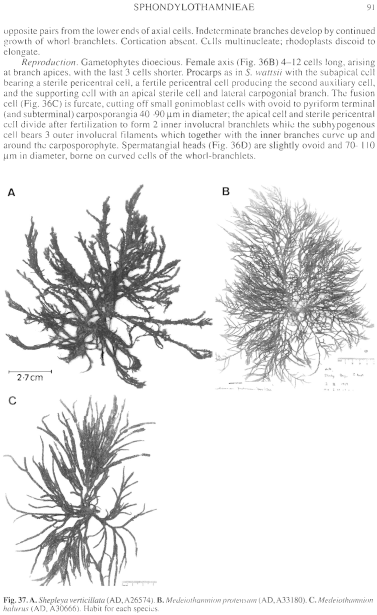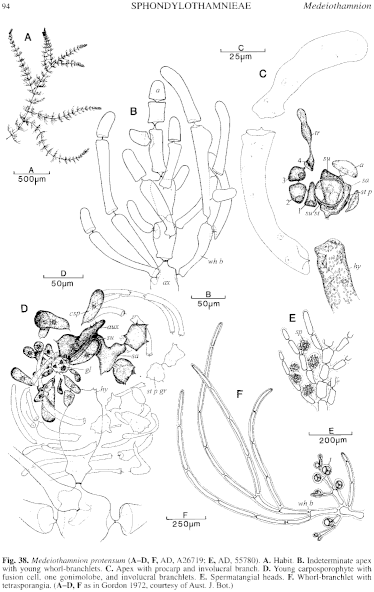|
|
|
|
|
|||||||||||
|
Electronic Flora of South Australia Species Fact Sheet
Phylum Rhodophyta – Order Ceramiales – Family Ceramiaceae – Tribe Sphondylothamnieae
Synonyms
Wrangelia protensa Harvey 1859b: 308; 1863, synop.: xxviii. J. Agardh 1876: 619. De Toni 1897: 130. Guiler 1952: 99. Lucas 1909: 23; 1929a: 16. Lucas & Perrin 1947: 137, fig. 10. May 1965: 366. Sonder 1881: 28. Tisdall 1898: 511. Wilson 1892: 170. Womersley 1950: 181; 1966: 152.
Mazoyera protensa (Harvey) Gordon 1970: 1498.
Thallus (Fig. 37B) medium red-brown to grey-red, 4–30 cm high, branching irregularly alternate and subdistichous for 3 orders; main axes erect, arising from prostrate axes, with cortication by descending rhizoids, forming an entwined holdfast 2–3 mm across, attached by haptera; epilithic. Structure. Subapical cells bearing 3–4 (–5) whorl-branchlets (Fig. 38A, B) developed in an opposite sequence, overlapping only near branch apices, mature branchlets with pinnate or subdichotomous, divergent, branches, tapering markedly, median cells 35–40 µm in diameter and L/D 5–6.5, terminal cells 18–22 µm in diameter, ends rounded. Axial cells enlarging to 800–1000 µm in diameter and 2–3 mm long near the thallus base. Indeterminate branches arise in position of whorl-branchlets. Cortication by descending branched rhizoids from the basal cells of whorl-branchlets, adhering by haptera. Cells multinucleate; rhodoplasts discoid.
Reproduction: Gametophytes probably dioecious. Female axes 6–7 cells long, formed in position of young whorl-branchlets; apical and subapical cells small and densely protoplasmic, the hypogenous cell elongate. Subapical cell bearing 2 sterile pericentral cells and the supporting cell with a sterile apical cell and a lateral carpogonial branch (Fig. 38C), and the hypogenous cell bearing a 2-celled, curved, involucral filament. The auxiliary cell becomes laterally elongate and, following contact via a connecting cell with the fertilized carpogonium, cuts off small gonimolobe initials (Fig. 38D) at each end; these become multinucleate and produce many 1–2-celled filaments with terminal, clavate, uninucleate carposporangia 30–40 µm in diameter, the mature carposporophyte 500–900 µm in diameter, with 2–5 gonimolobes from a lobed fusion cell. The apical cell, sterile pericentral cells, and sterile cell on the supporting cell produce 4 inner involucral branchlets (Fig. 38D), and the branchlet on the hypogenous cell develops as a normal whorl-branchlet and together with lower ones forms a loose outer involucrum. Spermatangial heads (Fig. 38E) ovoid, 35–65 µm in diameter, adaxial on cells of the whorl-branchlets.
Tetrasporangia (Fig. 38F) occur terminally or laterally on cells of small branchlets on the lower cells of whorl-branchlets, 60–75 µm in diameter, tetrahedrally divided.
Type from Port Phillip, Vic. (Harvey); lectotype in Herb. Harvey, TCD (Alg. Aust. Exsicc. 263F) - see Gordon 1972, p. 53.
Selected specimens: Port Turton, Yorke Pen., S. Aust., 8–10 m deep (Kald, 5.ix.1970; AD, A37251). 5 km W of Seacliff, S. Aust., 21 m deep (Ottaway, 11.xii.1980; AD, A52109). American R. inlet, Kangaroo I., S. Aust., 2–4 m deep near Muston (Womersley, 22.viii.1963; AD, A26849). Saunders Beach, Kangaroo I., S. Aust., drift (Womersley, 25.viii.1963; AD, A26719 and 29.ix.1964; AD, A30730). Stinky Bay, Nora Creina, S. Aust., drift (Wollaston, 2.iii.1969; AD, A33180). Port MacDonnell, S. Aust., drift (Womersley, 16.x.1985; AD, A56997). Brighton Beach, Vic., drift (Cappelli, 18.vi.1965; AD, A29290). Port Phillip (near Sandringham), Vic., 4 m deep (Macpherson, 15.xi.1959; AD, A24651). Crawfish Rock, Westernport Bay, Vic., 4 m deep (Watson, 17.xi.1974; AD, A46270). Low Head, Tas. (Perrin, 11.xi.1950; AD, A48172). Musselroe Bay, Tas. (Perrin, 7.ii.1948; AD, A48174). Crayfish Point, Taroona, Tas., 5 m deep (Brown, 24.x.1982; AD, A55780). Great Taylor Bay, Bruny I., Tas., 19 m deep (Shepherd, 14.ii.1972; AD, A42157).
Distribution: Port Turton, Yorke Pen., S. Aust., to Westernport, Vic., and N and E Tasmania.
Taxonomic notes: Medeiothamnion protensum occurs in conditions of slight water movement, either in shallow water (e.g. A26849, A46270) or in deeper water on rough-water coasts (e.g. A33180, A42157).
References:
AGARDH, J.G. (1876). Species Genera et Ordines Algarum. Vol. 3, Part 1- Epicrisis systematic Floridearum, pp. i-vii, 1–724. (Weigel: Leipzig.)
DE TONI, G.B. (1897). Sylloge Algarum omnium hucusque Cognitarum. Vol. 4. Florideae. Sect. 1, pp. 1–388. (Padua.)
GORDON, E.M. (1970). Mazoyera, nouveau genre de Céramiacées du Sud de l'Australie. C. R. hebd. Séanc. Acad. Sci. (Paris) 271, 1498–1500.
GORDON, E.M. (1972). Comparative morphology and taxonomy of the Wrangelieae, Sphondylothamnieae and Spermothamnieae (Ceramiaceae, Rhodophyta). Aust. J. Bot. suppl. 4, 1–180.
GUILER, E.R. (1952). The marine algae of Tasmania. Checklist with localities. Pap. Proc. R. Soc. Tasmania 86, 71–106.
HARVEY, W.H. (1859b). Algae. In Hooker, J.D., The Botany of the Antarctic Voyage. III. Flora Tasmaniae. Vol. II, pp. 282–343, Plates 185–196. (Reeve: London.)
HARVEY, W.H. (1863). Phycologia Australica. Vol. 5, Plates 241–300, synop., pp. i-lxxiii. (Reeve: London.)
LUCAS, A.H.S. & PERRIN, F. (1947). The Seaweeds of South Australia. Part 2. The Red Seaweeds. (Govt Printer: Adelaide.)
LUCAS, A.H.S. (1909). Revised list of the Fucoideae and Florideae of Australia. Proc. Linn. Soc. N.S.W. 34, 9–60.
LUCAS, A.H.S. (1929a). The marine algae of Tasmania. Pap. Proc. R. Soc. Tasm. 1928, 6–27.
MAY, V. (1965). A census and key to the species of Rhodophyceae (red algae) recorded from Australia. Contr. N.S.W. natn. Herb. 3, 349–429.
SONDER, O.W. (1881). In Mueller, F., Fragmenta Phytographiae Australiae. Supplementum ad volumen undecinum: Algae Australianae hactenus cognitae, pp. 1–42, 105–107. (Melbourne.)
TISDALL, H.T. (1898). The algae of Victoria. Rep. 7th Meet. Aust. Ass. Adv. Sci., Sydney, 1898, pp. 493–516.
WILSON, J.B. (1892). Catalogue of algae collected at or near Port Phillip Heads and Western Port. Proc. R. Soc. Vict. 4, 157–190.
WOMERSLEY, H.B.S. (1950). The marine algae of Kangaroo Island. III. List of Species 1. Trans. R. Soc. S. Aust. 73, 137–197.
WOMERSLEY, H.B.S. (1966). Port Phillip survey, 1957–1963: Algae. Mem. natn. Mus., Vict. No. 27, 133–156.
The Marine Benthic Flora of Southern Australia Part IIIC complete list of references.
Publication:
Womersley, H.B.S. (24 December, 1998)
The Marine Benthic Flora of Southern Australia
Rhodophyta. Part IIIC. Ceramiales – Ceramiaceae, Dasyaceae
©State Herbarium of South Australia, Government of South Australia
Illustrations in Womersley Part IIIA, 1998: FIGS 37B, 38.

Figure 37 enlarge
Fig. 37. A. Shepleya verticiliata (AD, A26574). B. Medeiothamnion protensum (AD, A33180). C. Medeiothamnion halurus (AD, A30666). Habit for each species.

Figure 38 enlarge
Fig. 38. Medeiothamnion protensum (A–D, F, AD, A26719; E, AD, 55780). A. Habit. B. Indeterminate apex with young whorl-branchlets. C. Apex with procarp and involucral branch. D. Young carposporophyte with fusion cell, one gonimolobe, and involucral branchlets. E. Spermatangial heads. F. Whorl-branchlet with tetrasporangia. (A–D, F, as in Gordon 1972, courtesy of Aust. J. Bot.)

|
Email Contact: State Herbarium of South Australia |

|